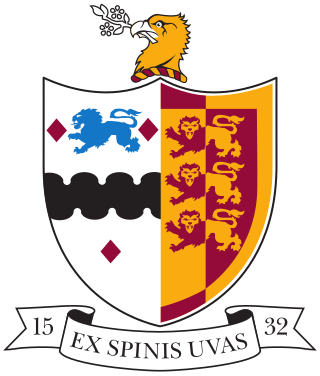
Bridgnorth is a town and civil parish in Shropshire, England. The River Severn splits it into High Town and Low Town, the upper town on the right bank and the lower on the left bank of the River Severn. The population at the 2011 Census was 12,079.

Bristol Grammar School (BGS) is a 4–18 mixed, private day school in Bristol, England. It was founded in 1532 by Royal Charter for the teaching of 'good manners and literature', endowed by wealthy Bristol merchants Robert and Nicholas Thorne. The school flourished in the early 20th century under headmaster Sir Cyril Norwood (1906–1916), embodying "the ideals and experiences of a leading public school". Norwood went on to serve as the master at Marlborough College and Harrow, and as president of St John's College, Oxford.
Arup is a British multinational professional services firm headquartered in London that provides design, engineering, architecture, planning, and advisory services across every aspect of the built environment. It employs about 17,000 people in over 90 offices across 35 countries, and has participated in projects in over 160 countries.

Smithdon High School is a small comprehensive school academy, with 627 students in Hunstanton, Norfolk. Its buildings are Grade II* listed. It changed its status, joining the West Norfolk Academies Trust in 2016. Ofsted rated the school as 'requires improvement' in 2019.

Sir Ove Nyquist Arup, CBE, MICE, MIStructE, FCIOB was an English engineer who founded Arup Group Limited, a multinational corporation that offers engineering, design, planning, project management, and consulting services for building systems. Ove Arup is considered to be among the foremost architectural structural engineers of his time.
Dormston School is a coeducational secondary school in Sedgley, West Midlands, England.
Clevedon School, formerly known as Clevedon Community School, is a coeducational secondary school located in Clevedon, North Somerset, England. It has over 1350 pupils, in years 7 to 11 in the Lower School and 12 to 13 in the Upper School or sixth form. The school recently regained its Language College status. As of 2023, the headteacher is Jim Smith. The school was part of the Clevedon Learning Trust, a Multi-Academy Trust formed on 1 January 2015 by CEO John Wells. As of 1st March 2023, Clevedon Learning Trust merged with Futura Learning Partnership, with schools in Bristol, North Somerset and Somerset.
Lincolnshire is one of the few counties within the UK that still uses the eleven-plus to decide who may attend grammar school, in common with Buckinghamshire and Kent.
The Deepings School is a coeducational secondary school and sixth form with academy status, located on Park Road in Deeping St James in Lincolnshire, England. As of April 2022, the school is attended by almost 1,500 pupils aged 11 to 18 taught by 90 teaching staff. It includes pupils from Stamford, Spalding, Langtoft, Baston, Bourne and the Deeping area.

Oldbury is a small village and former civil parish, now in the parish of Bridgnorth, in the Shropshire district, in the ceremonial county of Shropshire, England. It is situated approximately 1⁄2 mile (0.80 km) south of the market town of Bridgnorth. In 1951 the parish had a population of 283. On 1 April 1967 the civil parish of Oldbury was abolished and merged with Bridgnorth. The village remains separated from the town however and has a distinct character.

Queen Elizabeth's School (QEGS) is a non-selective academy school for 11- to 18-year-olds in the town of Ashbourne, Derbyshire, England. In the academic year 2009–10, there were 1,396 pupils on roll.

Sponne School in Towcester, Northamptonshire, England, is the oldest secondary school in Northamptonshire, and one of the oldest in the country. Part of the school was originally Towcester Grammar School, until Grammar schools were abolished in Northamptonshire. In 1968, the Grammar school was joined with the next-door Secondary Modern school, and the school was renamed Sponne, after Archdeacon William Sponne, who was Rector at the nearby St. Lawrence Church in the 15th century and the original founder of the school.
Derby Moor Academy, the successor school to Derby Moor Community Sports College Trust, formerly known as Derby Moor Community School, is a coeducational secondary school and sixth form situated on Moorway Lane, Littleover, Derby. It was established in January 2018 when the school converted to Academy status and joined the Spencer Academies Trust. It can also be seen as the successor to Derby School, which closed in 1989, resulting in Derby Moor opening in the same year with a new headteacher and governing body, although the buildings, pupils and most of the teaching staff were the same.

Woodkirk Academy is an academy located in Tingley, West Yorkshire, England. Established in 1948, the school now has over 1,800 pupils on roll, over 300 sixth form students and over 250 members of staff. Following Woodkirk gaining ‘Specialist Science Status', the school was briefly renamed Woodkirk High Specialist Science School from 2003 to 2011.
Ilkeston Grammar School was a selective co-educational secondary school, admission being dependent on passing the 11-plus examination. It stood on King George Avenue, Ilkeston, in the south east of Derbyshire in the East Midlands of England.
Bridgnorth Endowed School is a coeducational secondary school with academy status, located in the market town of Bridgnorth in the rural county of Shropshire, England. Founded in 1503, The Endowed School is a state school and is a specialist Technology College. The age range of the school is 11–18 years. It was previously known as the Bridgnorth Grammar School, and the school celebrated the 500th anniversary of its foundation in 2003. Former pupils include Professor Peter Bullock, the inspirational soil scientist who was a member of the Intergovernmental Panel on Climate Change (IPCC).
Walton Academy, formerly Walton Girls' High School is a co-ed secondary school, in Grantham, Lincolnshire, England. It is situated in the south-west of the town near the A607 junction with the A1. The school accepts approximately 135 girls a year. In September 2019, the school saw its first boys enter in year 7, previously boys were only in the sixth form.

The Piggott School is a Church of England academy secondary school in Wargrave in Berkshire, England. The school has approximately 1,516 pupils and around 185 teaching staff. The school specialises in Modern Languages and Humanities. It has been awarded International school status by the British Council. The most recent inspection from Ofsted achieved an overall effectiveness rating of 'Good'.
This article details a number of defunct schools that were once located in Sandwell in the West Midlands of England. For details of currently operating schools in Sandwell, please see: List of schools in Sandwell.

Liskeard School and Community College is a coeducational secondary school and sixth form with former engineering specialist status, located in Liskeard, Cornwall, England.










